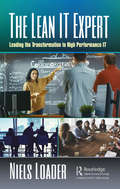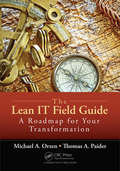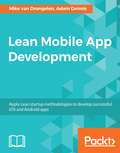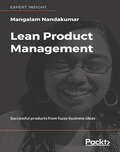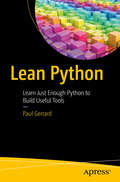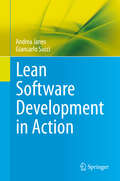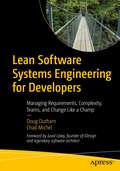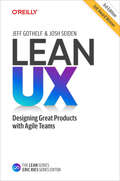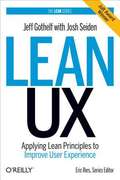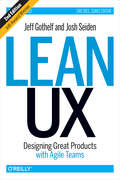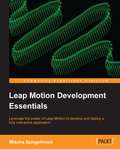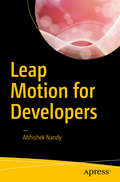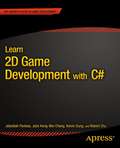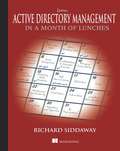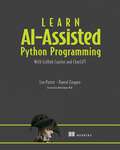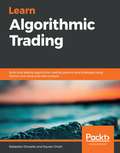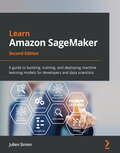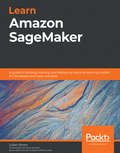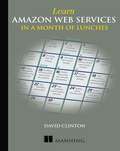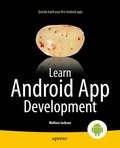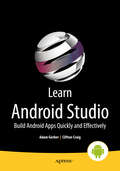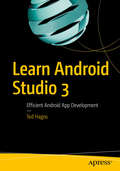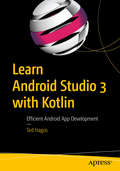- Table View
- List View
The Lean IT Expert: Leading the Transformation to High Performance IT
by Niels LoaderDigital transformation is a business concern; it is no longer just IT that must get things done. The disruptive force of start-ups focusing on IT-based services that can be consumed through mobile devices cannot be underestimated -- These start-ups eat away at the high-margin services provided by incumbents, leaving lower margin products and services that are rapidly being commoditized. This is happening in all industry sectors and it is the ones who are best able to adjust, innovate, and improve their service offerings that will survive. The question is: What do you need to do to ensure that your organization is one of the survivors? The core of the solution to the problem is to radically improve the way the IT organization works together with the business. To be clear, the digital transformation of your business depends on that relatively small group of people in the basement, or other out-of-the-way location, who make sure that your IT services work. So, building a cooperative model is vital for the success of the business. Which model has proven its worth in many industries? It is the application of Lean principles that gives organizations an advantage in delivering their products and services to their customers. Transforming your organization to high performance is, above all, a people-based movement with the acquisition and, most importantly, application of knowledge and skills necessary for the high performance way of working at its core. In teams, from boardroom to work floor, building a new way of thinking and acting is essential. This book aims to give insight into the reasons why you and your organization must consciously act to apply Lean principles to your IT organization. It explains the phases organizations go through as they start out with their initial attempts to gain advantages from Lean tools to the phase in which they reap the strategic benefits of Lean applied to IT. The real work of the transformation is described from two different perspectives: Leadership and Team. This book describes a complete set of principles, practices and tools In order to make the right decisions along the winding route of your transformation. The people who will guide, support and drive your transformation are the leaders and tem members who understand and apply those principles, practice and tools: your Lean IT Experts.
The Lean IT Field Guide: A Roadmap for Your Transformation
by Michael A. Orzen Thomas A. PaiderHow many IT books have you read that are long on theory and short on practical application? They are interesting, but not very impactful. They provide a framework from which to think and understand, but lack a process from which to act. Addressing this urgent need for the IT community, The Lean IT Field Guide explains how to initiate, execute, and sustain a lean IT transformation.Illuminating a clear path to lean IT, the authors integrate more than two decades of combined experience to provide you with a proven method for creating and sustaining a true lean IT workplace. This field guide not only highlights the organizational techniques of more agile and lean processes, but also the leadership work required to help management adopt these new approaches.Based on proven methods from different industries, including banking, manufacturing, insurance, food and beverage, and logistics, the book details a clear model that covers all the components you need to achieve and sustain a favorable work environment and culture in support of lean IT.Filled with anecdotes and case studies from actual businesses, the book includes pictures, templates, and examples that illustrate the application of the lean methods discussed.
The Lean IT Field Guide: A Roadmap for Your Transformation
by Michael A. Orzen Thomas A. PaiderHow many IT books have you read that are long on theory and short on practical application? They are interesting, but not very impactful. They provide a framework from which to think and understand, but lack a process from which to act. Addressing this urgent need for the IT community, The Lean IT Field Guide explains how to initiate, execute, and sustain a lean IT transformation.Illuminating a clear path to lean IT, the authors integrate more than two decades of combined experience to provide you with a proven method for creating and sustaining a true lean IT workplace. This field guide not only highlights the organizational techniques of more agile and lean processes, but also the leadership work required to help management adopt these new approaches.Based on proven methods from different industries, including banking, manufacturing, insurance, food and beverage, and logistics, the book details a clear model that covers all the components you need to achieve and sustain a favorable work environment and culture in support of lean IT.Filled with anecdotes and case studies from actual businesses, the book includes pictures, templates, and examples that illustrate the application of the lean methods discussed.
Lean Mobile App Development
by Alberto Gonzalez Mike Van Drongelen Adam Dennis Richard Garabedian Aravind KrishnaswamyDevelop lean iOS and Android apps using industry standard techniques and lean development practices. About This Book • Build ready-to-deploy apps with less iterations and shorter development times • Adopt the lean startup methodologies to develop iOS and Android apps that shine in the App Store • This hands-on guide puts continuous innovation into practice to develop successful mobile apps Who This Book Is For This book is for developers, CTOs, and architects working for a startup or another kind of lean startup environment, such as start-up within a cooperation. It is is ideal for any iOS and Android developer who wants to build successful mobile apps by adopting the lean startup methodology. What You Will Learn • Apply the lean startup methodology to real Android and iOS development • Define what your hypotheses are by creating an Minimal Viable Product • Validate your idea against the Business Model Canvas • Gather feedback through statistics and by getting user comments, learn from it, and adapt your app accordingly • Develop skills and devise strategies to build versatile and flexible apps that meet changing business requirements • Investigate the possibilities when you need to pivot your start-up idea whether in a startup or an established business. • Create a successful app and get tips on how to boostconversion and how to optimize the on boardingprocess. In Detail Lean is the ultimate methodology for creating a startup that succeeds. Sounds great from a theoretical point of view, but what does that mean for you as an a technical co-founder or mobile developer? By applying the Lean Start-up methodology to your mobile App development, it will become so much easier to build apps that take Google Play or the App Store by storm. This book shows you how to bring together smarter business processes with technical know-how. It makes no sense to develop a brilliant app for six months or longer only to find out later that nobody is interested in it. Build a Minimum Viable Product (MVP) first. Validate your hypotheses early and often. Discover effective product development strategies that let you put Facebook's famous axiom "move fast and break things" into practice. A great app without visibility and marketing clout is nothing, so use this book to market your app, making use of effective metrics that help you track and iterate all aspects of project performance. Style and approach This book takes a hands-on approach to developing apps through the Lean Start-up Methodology. Following a 50% business and 50% tech approach, this book is filled with practical examples and real-world experiments.
Lean Out: The Struggle For Gender Equality In Tech And Start-up Culture
by Elissa ShevinskyWhy aren't the great, qualified women already in tech being hired or promoted? Should people who don't fit in seek to join an institution that is actively hostile to them? Does the tech industry deserve women leaders? The split between the stated ideals of the corporate elite and the reality of working life for women in the tech industry--whether in large public tech companies or VC-backed start-ups, in anonymous gaming forums, or in Silicon Valley or Alley--seems designed to crush women's spirits. Corporate manifestos by women who already fit in (or who are able to convincingly fake it) aren't helping. There is a high cost for the generation of young women and transgender people currently navigating the harsh realities of the tech industry, who gave themselves to their careers only to be ignored, harassed and disrespected. Not everyone can be a CEO; not everyone is able to embrace a workplace culture that diminishes the contributions of women and ignores real complaints. The very culture of high tech, where foosball tables and endless supplies of beer are de facto perks, but maternity leave and breast-feeding stations are controversial, is designed to appeal to young men. Lean Out collects 25 stories from the modern tech industry, from people who fought GamerGate and from women and transgender artists who have made their own games, from women who have started their own companies and who have worked for some of the most successful corporations in America, from LGBTQ women, from women of color, from transgender people and people who do not ascribe to a gender. All are fed up with the glacial pace of cultural change in America's tech industry. Included are essays by anna anthropy, Leigh Alexander, Sunny Allen, Lauren Bacon, Katherine Cross, Dom DeGuzman, FAKEGRIMLOCK, Krys Freeman, Gesche Haas, Ash Huang, Erica Joy, Jenni Lee, Katy Levinson, Melanie Moore, Leanne Pittsford, Brook Shelley, Elissa Shevinsky, Erica Swallow, and Squinky. Edited and selected by entrepreneur and tech veteran Elissa Shevinsky, Lean Out sees a possible way forward that uses tech and creative disengagement to jettison 20th century corporate culture: ''I've figured out a way to create safe space for myself in tech,'' writes Shevinsky. ''I've left Silicon Valley, and now work remotely from home. I adore everyone on my team, because I hired them myself.
Lean Product Management: Successful products from fuzzy business ideas
by Mangalam NandakumarA guide to product management exploring the best practices: identifying the impact-driven product, planning for success, setting up and measuring time-bound metrics, and developing a lean product roadmap.Key FeaturesIdentifying Impact-Driven ProductsInvesting in Key Business OutcomesValue mapping to maintain a lean product backlogUtilizing time-bound product metricsEliminating process wasteBook DescriptionLean Product Management is about finding the smartest way to build an Impact Driven Product that can deliver value to customers and meet business outcomes when operating under internal and external constraints. Author, Mangalam Nandakumar, is a product management expert, with over 17 years of experience in the field. Businesses today are competing to innovate. Cost is no longer the constraint, execution is. It is essential for any business to harness whatever competitive advantage they can, and it is absolutely vital to deliver the best customer experience possible. The opportunities for creating impact are there, but product managers have to improvise on their strategy every day in order to capitalize on them. This is the Agile battleground, where you need to stay Lean and be able to respond to abstract feedback from an ever shifting market. This is where Lean Product Management will help you thrive. Lean Product Management is an essential guide for product managers, and to anyone embarking on a new product development. Mangalam Nandakumar will help you to align your product strategy with business outcomes and customer impact. She introduces the concept of investing in Key Business Outcomes as part of the product strategy in order to provide an objective metric about which product idea and strategy to pursue. You will learn how to create impactful end-to-end product experiences by engaging stakeholders and reacting to external feedback. What you will learnHow do you execute ideas that matter?How can you define the right success metrics?How can you plan for product success?How do you capture qualitative and quantitative insights about the product? How do you know whether your product aligns to desired business goals?What processes are slowing you down?Who this book is forIf you are leading a team that is building a new product, then this book is for you. The book is targeted at product managers, functional leads in enterprises, business sponsors venturing into new product offerings, product development teams, and start-up founders.
Lean Python
by Paul GerrardLearn only the essential aspects of Python without cluttering up your mind with features you may never use. This compact book is not a "best way to write code" type of book; rather, the author goes over his most-used functions, which are all you need to know as a beginner and some way beyond. Lean Python takes 58 Python methods and functions and whittles them down to 15: as author Paul Gerrard says, "I haven't found a need for the rest. " What You'll Learn Discover lean Python and how to learn just enough to build useful tools Use Python objects, program structure, I/O, modules and more Handle errors and exceptions Test your code Access the Web; do searching; and persist data Who This Book Is For This book is aimed at three categories of reader: The experienced programmer - if you already know a programming language, this book gives you a shortcut to understanding the Python language and some of its design philosophy. You work in IT and need a programming primer - you might be a tester who needs to have more informed technical discussions with programmers. Working through the examples will help you to appreciate the challenge of good programming. First-timer - you want a first book on programming that you can assimilate quickly to help you decide whether programming is for you.
Lean Software Development in Action
by Andrea Janes Giancarlo SucciThis book illustrates how goal-oriented, automated measurement can be used to create Lean organizations and to facilitate the development of Lean software, while also demonstrating the practical implementation of Lean software development by combining tried and trusted tools. In order to be successful, a Lean orientation of software development has to go hand in hand with a company's overall business strategy. To achieve this, two interrelated aspects require special attention: measurement and experience management. In this book, Janes and Succi provide the necessary knowledge to establish "Lean software company thinking," while also exploiting the latest approaches to software measurement. A comprehensive, company-wide measurement approach is exactly what companies need in order to align their activities to the demands of their stakeholders, to their business strategy, etc. With the automatic, non-invasive measurement approach proposed in this book, even small and medium-sized enterprises that do not have the resources to introduce heavyweight processes will be able to make their software development processes considerably more Lean. The book is divided into three parts. Part I, "Motivation for Lean Software Development," explains just what "Lean Production" means, why it can be advantageous to apply Lean concepts to software engineering, and which existing approaches are best suited to achieving this. Part II, "The Pillars of Lean Software Development," presents the tools needed to achieve Lean software development: Non-invasive Measurement, the Goal Question Metric approach, and the Experience Factory. Finally, Part III, "Lean Software Development in Action," shows how different tools can be combined to enable Lean Thinking in software development. The book primarily addresses the needs of all those working in the field of software engineering who want to understand how to establish an efficient and effective software development process. This group includes developers, managers, and students pursuing an M. Sc. degree in software engineering.
Lean Software Systems Engineering for Developers: Managing Requirements, Complexity, Teams, and Change Like a Champ
by Doug Durham Chad MichelGraduate to the next level of your software development career, learning the tools you need to successfully manage the complexity of modern software systems.Whether you are a developer at a small software company, or one of many developers at a large enterprise, your success directly correlates to the ability of your development team to rapidly respond to change. What makes this task challenging in today’s world, is that the technical challenges we as developers strive to overcome are becoming increasingly more complex. We have to consider many more options when it comes to things like requirements, solution hosting, support, pace of change, and generally with less time and warning.A good developer knows that it is critical to manage every aspect of software development from soup to nuts, and understands that when details and decisions are left to chance, outcomes can be negatively impacted. Poor planning can result in increased errors, substandard quality, budget and schedule overruns, and result in the ultimate business failure, dissatisfied customers, and stakeholders.This book will help you put on the lenses of a software engineer. You will come away with an understanding of how to view the entire spectrum of the software development process, learn valuable concepts, and apply these principles through meaningful examples, case studies, and source code. What You Will LearnMove beyond being a programmer to being a professional software engineerSpend more time doing software development; minimize time spent dealing with ineffective or inadequate processesReduce errors in judgment and provide predictable outcomes, while still maintaining agility and responsiveness using Lean and Agile practicesKnow the steps you can take to ensure a shared understanding among stakeholdersDiscover tools to validate user experience early and often to minimize costly re-workDevelop software designs and architectures that enable long-term business agilityImplement patterns and processes that result in “falling into the pit of success” instead of into the “pit of failure”Adopt processes and patterns that will result in pervasive “institutionalized” qualityUnderstand the necessity of redefining the essential role of technical leadership to ensure team maturity and growth Who This Book Is ForSoftware developers and team leaders who have struggled to implement design and development best practices due to lack of team resources, in-depth knowledge, or experience, and want a book designed to provide the confidence and foundational skills needed to achieve success
Lean UX
by Jeff Gothelf Josh SeidenLean UX is synonymous with modern product design and development. By combining human-centric design, agile ways of working, and a strong business sense, designers, product managers, developers, and scrum masters around the world are making Lean UX the leading approach for digital product teams today.In the third edition of this award-winning book, authors Jeff Gothelf and Josh Seiden help you focus on the product experience rather than deliverables. You'll learn tactics for integrating user experience design, product discovery, agile methods, and product management. And you'll discover how to drive your design in short, iterative cycles to assess what works best for businesses and users. Lean UX guides you through this change--for the better.Facilitate the Lean UX process with your team with the Lean UX CanvasEnsure every project starts with clear customer-centric success criteriaUnderstand the role of designer on a agile teamWrite and contribute design and experiment stories to the backlogEnsure that design work takes place in every sprintBuild product discovery into your team's "velocity"
Lean UX: Applying Lean Principles to Improve User Experience
by Jeff Gothelf Josh Seiden<p>The Lean UX approach to interaction design is tailor-made for today’s web-driven reality. In this insightful book, leading advocate Jeff Gothelf teaches you valuable Lean UX principles, tactics, and techniques from the ground up—how to rapidly experiment with design ideas, validate them with real users, and continually adjust your design based on what you learn.</p>
Lean UX: Designing Great Products with Agile Teams
by Josh Seiden Jeff GothelfUX design has traditionally been deliverables-based. Wireframes, site maps, flow diagrams, content inventories, taxonomies, mockups helped define the practice in its infancy.Over time, however, this deliverables-heavy process has put UX designers in the deliverables business. Many are now measured and compensated for the depth and breadth of their deliverables instead of the quality and success of the experiences they design. Designers have become documentation subject matter experts, known for the quality of the documents they create instead of the end-state experiences being designed and developed.So what's to be done? This practical book provides a roadmap and set of practices and principles that will help you keep your focus on the the experience back, rather than the deliverables.Get a tactical understanding of how to successfully integrate Lean and UX/DesignFind new material on business modeling and outcomes to help teams work more strategicallyDelve into the new chapter on experiment designTake advantage of updated examples and case studies
Leap Motion Development Essentials
by Mischa SpiegelmockThis book is a fast-paced guide with practical examples that aims to help you understand and master the Leap Motion SDK.This book is for developers who are either involved in game development or who are looking to utilize Leap Motion technology in order to create brand new user interaction experiences to distinguish their products from the mass market. You should be comfortable with high-level languages and object-oriented development concepts in order to get the most out of this book.
Leap Motion for Developers
by Abhishek NandyDevelop apps and games using the Leap Motion sensor. This book starts with a brief introduction to Leap Motion, then covers getting the Leap Motion working and setting up a Leap Motion development environment. Leap Motion for Developers also covers the life cycle of how you interact with Leap Motion and the workflow of making a complete app. You'll see how to use different programming languages for simple and steady development. The next part of the book walks through the basics of Leap Motion with Python and Java. We will then work on using Leap Motion with Unity, where we will build an app using Unity and then add different functionality to it. In the last part we cover Unreal 4, Processing, and JavaScript for Leap Motion. What You Will Learn Look at the basics of Leap Motion Develop apps for the Leap Motion sensor See how different languages work with Leap Motion Discover the future of Leap Motion Who This Book Is For Students, developers, game developers, and tech enthusiasts.
Learn 2D Game Development with C#
by Jebediah Pavleas Jack Keng-Wei Chang Kelvin Sung Robert Zhu2D games are hugely popular across a wide range of platforms and the ideal place to start if you're new to game development. With Learn 2D Game Development with C#, you'll learn your way around the universal building blocks of game development, and how to put them together to create a real working game. C# is increasingly becoming the language of choice for new game developers. Productive and easier to learn than C++, C# lets you get your games working quickly and safely without worrying about tricky low-level details like memory management. This book uses MonoGame, an open source framework that's powerful, free to use and easy to handle, to further reduce low-level details, meaning you can concentrate on the most interesting and universal aspects of a game development: frame, camera, objects and particles, sprites, and the logic and simple physics that determines how they interact. In each chapter, you'll explore one of these key elements of game development in the context of a working game, learn how to implement the example for yourself, and integrate it into your own game library. At the end of the book, you'll put everything you've learned together to build your first full working game! And what's more, MonoGame is designed for maximum cross-platform support, so once you've mastered the fundamentals in this book, you'll be ready to explore and publish games on a wide range of platforms including Windows 8, MAC OSX, Windows Phone, iOS, Android, and Playstation Mobile. Whether you're starting a new hobby or considering a career in game development, Learn 2D Game Development with C# is the ideal place to start. What you'll learn Know your way around the world of game design and the process of designing a game from scratch. Understand the basic architecture of a 2D game engine and develop your own game library. Work with the MonoGame framework and use it to build your own 2D interactive games. Learn and implement simple in-game pseudo autonomous behaviors. Understand and implement the math and physics underlying realistic game interactions. Give your game impact with graphic effects, and audio and special effects. Who this book is for This book is perfect for game enthusiasts, hobbyists, and anyone who is interested in building interactive games but is unsure of how to begin. It assumes no background in computer graphics or game development, but readers should be familiar with C# or another object-oriented language. Table of Contents Introducing 2D Game Development in C# Getting to Know the MonoGame Framework 2D Graphics, Coordinates, and Game State Getting Things Moving Pixel-Accurate Collisions Game Object States and Semiautonomous Behaviors Sprites, Camera, Action! Particle Systems Building Your First 2D Game
Learn Active Directory Management in a Month of Lunches
by Richard SiddawaySummaryLearn Active Directory Management in a Month of Lunches is a practical, hands-on tutorial designed for IT pros new to Active Directory. It skips the theory and concentrates on the day-to-day administration tasks you need to know to keep your network running smoothly. Just set aside an hour a day for a month—lunchtime would be perfect—and you'll be comfortable and productive with Active Directory before you know it.About the BookAt the heart of your Windows network is Active Directory, the control center for administration, security, and other core management functions. If you're new to Active Directory administration—or if you find yourself unexpectedly thrust into that role—you'll need to get up to speed fast.Learn Active Directory Management in a Month of Lunches is a hands-on tutorial designed for IT pros new to Active Directory. Without assuming previous administration experience, the book starts by walking you through the most important day-to-day system management tasks. You'll learn how to administer AD both from the GUI tools built into Windows and by using PowerShell at the command line. Along the way, you'll touch on best practices for managing user access, setting group policies, automating backups, and more.This book assumes no prior experience with Active Directory or Windows administration. Examples are based in Windows Server 2012Purchase of the print book includes a free eBook in PDF, Kindle, and ePub formats from Manning Publications.What's InsideADM tasks you'll need every dayGUI and command line techniquesContent tested by new administratorsWell-illustrated, clearly explained examplesAbout the AuthorRichard Siddaway is an experienced all-around Windows administrator with two decades of experience. He's the author of PowerShell in Practice andPowerShell and WMI, and coauthor of PowerShell in Depth.Table of ContentsPART 1 MANAGING ACTIVE DIRECTORY DATABefore you beginCreating user accountsManaging user accountsManaging groupsTroubleshooting users and groupsManaging computer accountsManaging organizational unitsPART 2 MANAGING GROUP POLICYCreating Group PoliciesManaging Group PoliciesFine-grained password policiesPART 3 MANAGING THE ACTIVE DIRECTORY SERVICECreating domain controllersManaging domain controllersProtecting AD data Security: Default groups and delegationManaging DNSManaging sites and subnetsAD replicationManaging AD trustsPART 4 MAINTENANCE AND TROUBLESHOOTINGTroubleshooting your AD Maintaining and monitoring Active DirectoryFuture work and final examInto the cloud
Learn AI-assisted Python Programming: With GitHub Copilot and ChatGPT
by Leo PorterWriting computer programs in Python just got a lot easier! Use AI-assisted coding tools like GitHub Copilot and ChatGPT to turn your ideas into applications faster than ever.AI has changed the way we write computer programs. With tools like Copilot and ChatGPT, you can describe what you want in plain English, and watch your AI assistant generate the code right before your eyes. It&’s perfect for beginners, or anyone who&’s struggled with the steep learning curve of traditional programming. In Learn AI-Assisted Python Programming: With GitHub Copilot and ChatGPT you&’ll learn how to: Write fun and useful Python applications—no programming experience required! Use the Copilot AI coding assistant to create Python programs Write prompts that tell Copilot exactly what to do Read Python code and understand what it does Test your programs to make sure they work the way you want them to Fix code with prompt engineering or human tweaks Apply Python creatively to help out on the job Learn AI-Assisted Python Programming: With GitHub Copilot and ChatGPT is a hands-on beginner&’s guide that is written by two esteemed computer science university professors. It teaches you everything you need to start programming Python in an AI-first world. You&’ll hit the ground running, writing prompts that tell your AI-assistant exactly what you want your programs to do. Along the way, you&’ll pick up the essentials of Python programming and practice the higher-level thinking you&’ll need to create working apps for data analysis, automating tedious tasks, and even video games. Foreword by Beth Simon, Ph.D. About the technology The way people write computer programs has changed forever. Using GitHub Copilot, you describe in plain English what you want your program to do, and the AI generates it instantly. About the book This book shows you how to create and improve Python programs using AI—even if you&’ve never written a line of computer code before. Spend less time on the slow, low-level programming details and instead learn how an AI assistant can bring your ideas to life immediately. As you go, you&’ll even learn enough of the Python language to understand and improve what your AI assistant creates. What's inside Prompts for working code Tweak code manually and with AI help AI-test your programs Let AI handle tedious details About the reader If you can move files around on your computer and install new programs, you can learn to write useful software! About the author Dr. Leo Porter is a Teaching Professor at UC San Diego. Dr. Daniel Zingaro is an Associate Teaching Professor at the University of Toronto. The technical editor on this book was Peter Morgan. Table of Contents 1 Introducing AI-assisted programming with Copilot 2 Getting started with Copilot 3 Designing functions 4 Reading Python code – Part 1 5 Reading Python Code – Part 2 6 Testing and prompt engineering 7 Problem decomposition 8 Debugging and better understanding your code 9 Automating tedious tasks 10 Making some games 11 Future directions
Learn Algorithmic Trading: Build and deploy algorithmic trading systems and strategies using Python and advanced data analysis
by Sebastien Donadio Sourav GhoshUnderstand the fundamentals of algorithmic trading to apply algorithms to real market data and analyze the results of real-world trading strategies Key Features Understand the power of algorithmic trading in financial markets with real-world examples Get up and running with the algorithms used to carry out algorithmic trading Learn to build your own algorithmic trading robots which require no human intervention Book Description It's now harder than ever to get a significant edge over competitors in terms of speed and efficiency when it comes to algorithmic trading. Relying on sophisticated trading signals, predictive models and strategies can make all the difference. This book will guide you through these aspects, giving you insights into how modern electronic trading markets and participants operate. You'll start with an introduction to algorithmic trading, along with setting up the environment required to perform the tasks in the book. You'll explore the key components of an algorithmic trading business and aspects you'll need to take into account before starting an automated trading project. Next, you'll focus on designing, building and operating the components required for developing a practical and profitable algorithmic trading business. Later, you'll learn how quantitative trading signals and strategies are developed, and also implement and analyze sophisticated trading strategies such as volatility strategies, economic release strategies, and statistical arbitrage. Finally, you'll create a trading bot from scratch using the algorithms built in the previous sections. By the end of this book, you'll be well-versed with electronic trading markets and have learned to implement, evaluate and safely operate algorithmic trading strategies in live markets. What you will learn Understand the components of modern algorithmic trading systems and strategies Apply machine learning in algorithmic trading signals and strategies using Python Build, visualize and analyze trading strategies based on mean reversion, trend, economic releases and more Quantify and build a risk management system for Python trading strategies Build a backtester to run simulated trading strategies for improving the performance of your trading bot Deploy and incorporate trading strategies in the live market to maintain and improve profitability Who this book is for This book is for software engineers, financial traders, data analysts, and entrepreneurs. Anyone who wants to get started with algorithmic trading and understand how it works; and learn the components of a trading system, protocols and algorithms required for black box and gray box trading, and techniques for building a completely automated and profitable trading business will also find this book useful.
Learn Amazon SageMaker: A guide to building, training, and deploying machine learning models for developers and data scientists, 2nd Edition
by Julien SimonSwiftly build and deploy machine learning models without managing infrastructure and boost productivity using the latest Amazon SageMaker capabilities such as Studio, Autopilot, Data Wrangler, Pipelines, and Feature StoreKey FeaturesBuild, train, and deploy machine learning models quickly using Amazon SageMakerOptimize the accuracy, cost, and fairness of your modelsCreate and automate end-to-end machine learning workflows on Amazon Web Services (AWS)Book DescriptionAmazon SageMaker enables you to quickly build, train, and deploy machine learning models at scale without managing any infrastructure. It helps you focus on the machine learning problem at hand and deploy high-quality models by eliminating the heavy lifting typically involved in each step of the ML process. This second edition will help data scientists and ML developers to explore new features such as SageMaker Data Wrangler, Pipelines, Clarify, Feature Store, and much more. You'll start by learning how to use various capabilities of SageMaker as a single toolset to solve ML challenges and progress to cover features such as AutoML, built-in algorithms and frameworks, and writing your own code and algorithms to build ML models. The book will then show you how to integrate Amazon SageMaker with popular deep learning libraries, such as TensorFlow and PyTorch, to extend the capabilities of existing models. You'll also see how automating your workflows can help you get to production faster with minimum effort and at a lower cost. Finally, you'll explore SageMaker Debugger and SageMaker Model Monitor to detect quality issues in training and production. By the end of this Amazon book, you'll be able to use Amazon SageMaker on the full spectrum of ML workflows, from experimentation, training, and monitoring to scaling, deployment, and automation.What you will learnBecome well-versed with data annotation and preparation techniquesUse AutoML features to build and train machine learning models with AutoPilotCreate models using built-in algorithms and frameworks and your own codeTrain computer vision and natural language processing (NLP) models using real-world examplesCover training techniques for scaling, model optimization, model debugging, and cost optimizationAutomate deployment tasks in a variety of configurations using SDK and several automation toolsWho this book is forThis book is for software engineers, machine learning developers, data scientists, and AWS users who are new to using Amazon SageMaker and want to build high-quality machine learning models without worrying about infrastructure. Knowledge of AWS basics is required to grasp the concepts covered in this book more effectively. A solid understanding of machine learning concepts and the Python programming language will also be beneficial.
Learn Amazon SageMaker: A guide to building, training, and deploying machine learning models for developers and data scientists
by Julien Simon Francesco PochettiQuickly build and deploy machine learning models without managing infrastructure, and improve productivity using Amazon SageMaker's capabilities such as Amazon SageMaker Studio, Autopilot, Experiments, Debugger, and Model Monitor Key Features Build, train, and deploy machine learning models quickly using Amazon SageMaker Analyze, detect, and receive alerts relating to various business problems using machine learning algorithms and techniques Improve productivity by training and fine-tuning machine learning models in production Book Description Amazon SageMaker enables you to quickly build, train, and deploy machine learning (ML) models at scale, without managing any infrastructure. It helps you focus on the ML problem at hand and deploy high-quality models by removing the heavy lifting typically involved in each step of the ML process. This book is a comprehensive guide for data scientists and ML developers who want to learn the ins and outs of Amazon SageMaker. You'll understand how to use various modules of SageMaker as a single toolset to solve the challenges faced in ML. As you progress, you'll cover features such as AutoML, built-in algorithms and frameworks, and the option for writing your own code and algorithms to build ML models. Later, the book will show you how to integrate Amazon SageMaker with popular deep learning libraries such as TensorFlow and PyTorch to increase the capabilities of existing models. You'll also learn to get the models to production faster with minimum effort and at a lower cost. Finally, you'll explore how to use Amazon SageMaker Debugger to analyze, detect, and highlight problems to understand the current model state and improve model accuracy. By the end of this Amazon book, you'll be able to use Amazon SageMaker on the full spectrum of ML workflows, from experimentation, training, and monitoring to scaling, deployment, and automation. What you will learn Create and automate end-to-end machine learning workflows on Amazon Web Services (AWS) Become well-versed with data annotation and preparation techniques Use AutoML features to build and train machine learning models with AutoPilot Create models using built-in algorithms and frameworks and your own code Train computer vision and NLP models using real-world examples Cover training techniques for scaling, model optimization, model debugging, and cost optimization Automate deployment tasks in a variety of configurations using SDK and several automation tools Who this book is for This book is for software engineers, machine learning developers, data scientists, and AWS users who are new to using Amazon SageMaker and want to build high-quality machine learning models without worrying about infrastructure. Knowledge of AWS basics is required to grasp the concepts covered in this book more effectively. Some understanding of machine learning concepts and the Python programming language will also be beneficial.
Learn Amazon Web Services in a Month of Lunches
by David ClintonSummaryLearn Amazon Web Services in a Month of Lunches guides you through the process of building a robust and secure web application using the core AWS services you really need to know. You'll be amazed by how much you can accomplish with AWS!Purchase of the print book includes a free eBook in PDF, Kindle, and ePub formats from Manning Publications.About the TechnologyCloud computing has transformed the way we build and deliver software. With the Amazon Web Services cloud platform, you can trade expensive glass room hardware and custom infrastructure for virtual servers and easy-to-configure storage, security, and networking services. Better, because you don't own the hardware, you only pay for the computing power you need! Just learn a few key ideas and techniques and you can have applications up and running in AWS in minutes.About the BookLearn Amazon Web Services in a Month of Lunches gets you started with AWS fast. In just 21 bite-size lessons, you'll learn the concepts and practical techniques you need to deploy and manage applications. You'll learn by doing real-world labs that guide you from the core AWS tool set through setting up security and storage and planning for growth. You'll even deploy a public-facing application that's highly available, scalable, and load balanced. What's InsideFirst steps with AWS - no experience requiredDeploy web apps using EC2, RDS, S3, and Route 53Cheap and fast system backupsSetting up cloud automationAbout the ReaderIf you know your way around Windows or Linux and have a basic idea of how web applications work, you're ready to start using AWS. About the AuthorDavid Clinton is a system administrator, teacher, and writer. He has administered, written about, and created training materials for many important technology subjects including Linux systems, cloud computing (AWS in particular), and container technologies like Docker. Many of his video training courses can be found on Pluralsight.com, and links to his other books (on Linux administration and server virtualization) can be found at https://bootstrap-it.com.Table of ContentsBefore you beginPART 1 - THE CORE AWS TOOLSThe 10-minute EC2 web serverProvisioning a more robust EC2 websiteDatabases on AWSDNS: what’s in a name?S3: cheap, fast file storageS3: cheap, fast system backupsAWS security: working with IAM users, groups, and rolesManaging growthPushing back against the chaos: using resource tagsCloudWatch: monitoring AWS resources for fun and profitAnother way to play: the command-line interfacePART 2 - THE AWS POWER USER: OPTIMIZING YOUR INFRASTRUCTUREKeeping ahead of user demandHigh availability: working with AWS networking toolsHigh availability: load balancingHigh availability: auto scalingHigh availability: content-delivery networksPART 3 - FOOD FOR THOUGHT: WHAT ELSE CAN AWS DO FOR YOU?Building hybrid infrastructureCloud automation: working with Elastic Beanstalk, Docker, and LambdaEverything else (nearly)Never the end
Learn Android App Development
by Wallace JacksonLearn Android App Development is a hands-on tutorial and useful reference. You'll quickly get up to speed and master the Android SDK and the Java that you need for your Android Apps. The Android SDK offers powerful features, and this book is the fastest path to mastering them-and the rest of the Andorid SDK-for programmers with some experience who are new to Android smartphone and tablet apps development. Many books introduce the Android SDK, but very few explain how to develop apps optimally. This book teaches both core Java language concepts and how to wisely but rapidly employ the design patterns and logic using the Android SDK, which is based on Java APIs. You'll also learn best practices that ensure your code will be efficient and perform well. Get an accelerated but complete enough treatment of the fundamentals of Java necessary to get you started. Design your first app using prototyping and other design methods. Build your first Android app using the code given over the course of the book. Finally, debug and distribute your first app on Google Play or other Android app store. After reading this book, you'll have your first app ready and on the app store, earning you the prestige and the money you seek.
Learn Android Studio
by Adam Gerber Clifton CraigLearn Android Studio covers Android Studio and its rich tools ecosystem, including Git and Gradle: this book covers how Android Studio works seamlessly with Git, for source control, and Gradle, a build and test tool. In addition, this book demonstrates how to develop/collaborate with remote Git web-hosting services such as GitHub and Bitbucket. Four complete Android projects accompany this volume and are available for download from a public Git repository. With this book, you learn the latest and most productive tools in the Android tools ecosystem, and the best practices for Android app development. You will be able to take away the labs' code as templates or frameworks to re-use and customize for your own similar apps. Android Studio is an intuitive, feature-rich, and extremely forgiving Integrated Development Environment (IDE). This IDE is more productive and easier to use for your Android app creations than Eclipse. With this book you will quickly master Android Studio and maximize your Android development time. Source code on the remote web-hosting service is targeted to the latest Android Studio release, version 1. 2. What you'll learn How to get started with the Android Studio IDE How to navigate and use Android Studio How to do version control with Git How to use Gradle How to use the new Android Wear framework How to debug your code using Android Studio How to manage your app projects How to test your apps How to analyze and refactor your code How to customize Android Studio Who this book is for This book is for Android app developers new to this IDE tool. Table of Contents 1. Introducing Android Studio 2. Navigating 3. Programming 4. Refactoring 5. Reminders Lab: Part 1 6. Reminders Lab: Part 2 7. Git 8. Layouts 9. Currencies Lab: Part 1 10. Currencies Lab: Part 2 11. Testing and Analyzing 12. Debugging 13. Gradle 14. More SDK Tools 15. Wear 16. Customizing Android Studio
Learn Android Studio 3
by Ted HagosBuild Android apps using the popular and efficient Android Studio 3 suite of tools, an integrated development environment (IDE) for Android developers using Java APIs. With this book, you’ll learn the latest and most productive tools in the Android tools ecosystem, ensuring quick Android app development and minimal effort on your part. Along the way, you’ll use Android Studio to develop Java-based Android apps, tier by tier through practical examples. These examples cover core Android topics such as notifications and toast; intents and broadcast receivers; and services. Then, you’ll learn how to publish your apps and sell them online and in the Google Play store. What You'll LearnUse Android Studio 3 to quickly and confidently build your first Android appsBuild an Android user interface using activities and layouts, event handling, images, menus and the action barIncorporate new elements including fragmentsIntegrate data with data persistence Access the cloud Who This Book Is ForThose who may be new to Android Studio 3 or Android Studio in general. You may or may not be new to Android development in general. Some prior experience with Java is also recommended.
Learn Android Studio 3 with Kotlin: Efficient Android App Development
by Ted HagosBuild Android apps using the popular and efficient Android Studio 3 suite of tools, an integrated development environment (IDE) with which Android developers can now use the Kotlin programming language. With this book, you’ll learn the latest and most productive tools in the Android tools ecosystem, ensuring quick Android app development and minimal effort on your part. Along the way, you’ll use Android Studio to develop apps tier by tier through practical examples. These examples cover core Android topics such as Activities, Intents, BroadcastReceivers, Services and AsyncTask. Then, you’ll learn how to publish your apps and sell them online and in the Google Play store.What You’ll LearnUse Android Studio 3 to quickly and confidently build your first Android appsBuild an Android user interface using activities and layouts, event handling, images, menus and the action barIncorporate new elements including fragmentsLearn how data is persisted Use Kotlin to build appsWho This Book Is ForThose who may be new to Android Studio 3 or Android Studio in general. You may or may not be new to Android development in general. Some prior experience with Java is also recommended.
